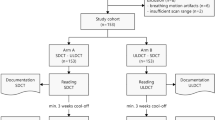Abstract
Single photon emission computed tomography (ECT) was performed on 67 patients. ECT images were taken with a Shimadzu scintillation camera, LFOV-E, before a delayed scan.
Eighteen of 67 patients showed abnormal findings on the ECT images. Fourteen of the 18 had a transmission X-ray CT (TCT) study as well. There were eleven cases with brain metastases, one case each of an old infarction, a skull metastasis, and a surgical wound. Eleven of fortynine ECT-negative patients had a TCT study as well, and intracranial lesions were found in five. The smallest lesion found by ECT was 0.5 cm in diameter on the TCT image and the largest lesion missed by ECT was a tumor in the corpus callosum, measuring 4.2×2.7 cm.
As far as the patients who also received TCT study are concerned, both the ECT and the ordinary scan were thought to be equal in sixteen patients and ECT to be superior in seven whereas the ordinary scintigram was superior in two. At present, ECT is considered to be useful when it is used in addition to the ordinary scans.
In the field of clinical nuclear medicine, the development of new radiopharmaceuticals which are labeled with single photon emitters and which can show the metabolic activity of the brain is eagerly awaited.
Similar content being viewed by others
References
Bonte FJ, Stokely EM (1981) Single-photon tomographic study of regional cerebral blood flow after stroke: Concise communication. JNM 22:1049–1053
Carril JM, MacDonald AF, Dendy PP, Keyes WI, Undrill PE, Mallard JR (1979) Cranial scintigraphy: Value of adding emission computed tomographic sections to conventional pertechnetate images (512 cases). JNM 20:1117–1123
Cochavi S, Pohost GM, Elmaleh DR, Strauss HW (1979) Transverse-sectional imaging with Na18F in myocardial infarction. JNM 20:1013–1017
Fischer KC, McKusick KA, Pendergrass HP, Potsaid MS (1975) Improved brain scan specificity utilizing 99mTc(Sn)-diphosphonate. JNM 16:705–708
Grames GM, Jansen C, Carlsen EN, Davidson TR (1975) The abnormal bone scan in intracranial lesions. Radiology 115:129–134
Hill TC, Lovett RD, McNeil BJ (1980) Observations on the clinical value of emission tomography. JNM 21:613–616
Hill TC, Holman BL, Lovett R, O'Leary DH, Front D, Magistretti P, Zimmerman RE, Moore S, Clouse ME, Wu JL, Lin TH, Baldwin RM (1982) Initial experience with SPECT (singlephoton computerized tomography) of the brain using N-isopropyl I-123 p-iodoamphetamine: Concise communication. JNM 23:191–195
Hounsfield GN (1973) Computerized transaxial scanning (tomography): Part 1. Description of system. Br J Radiol 46:1016–1022
Kuhl DE, Edwards RO (1963) Image separation radioisotope scanning. Radiology 80:653–661
Kuhl DE, Reivich M, Alavi A, Nyary I, Staum MM (1975) Local cerebral blood volume determined by three-dimensional reconstruction of radionuclide scan data. Circ Res 36:610–619
Kuhl DE, Phelps ME, Kowell AP, Metter EJ, Selin C, Winter J (1980a) Effects of stroke on local cerebral metabolism and perfusion: Mapping by emission computed tomography of 18FDG and 13NH3. Ann Neurol 8:47–60
Kuhl DE, Engel J Jr, Phelps ME, Selin C (1980b) Epileptic patterns of local cerebral metabolism and perfusion in humans determined by emission computed tomography of 18FDG and 13NH3. Ann Neurol 8:348–360
Kuhl DE, Barrio JR, Huang SC, Selin C, Ackermann RF, Lear JL, Wu JL, Lin TH, Phelps ME (1982) Quantifying local cerebral blood flow by N-isopropyl-p-[123I]iodoamphetamine (IMP) tomography. JNM 23:196–203
Maeda T, Matsuda H, Hisada K, Tonami N, Mori H, Fujii H, Hayashi M, Yamamoto S (1981) Three-dimensional regional cerebral blood perfusion images with single-photon emission computed tomography. Radiology 140:817–822
Oyamada H, Fukukita H, Terui S, Uehara T, Kawai H (1981) Radionuclide computed tomography (RCT) of the liver using a rotating chair (author's transl.). Jpn J Nucl Med 18:63–73
Soussaline F, Todd-Pokropek AE, Plummer D, Comar D, Loch C, Houle S, Kellershohn C (1979) The physical performances of a single slice positron tomographic system and preliminary results in a clinical environment. Eur J Nucl Med 4:237–249
Watson NE Jr., Cowan RJ, Ball MR, Moody DM, Laster DW, Maynard CD (1980) A comparison of brain imaging with gamma camera, single-photon emission computed tomography, and transmission computed tomography: Concise communication. JNM 21:507–511
Author information
Authors and Affiliations
Rights and permissions
About this article
Cite this article
Oyamada, H., Terui, S., Fukukita, H. et al. Clinical evaluation of single photon emission computed tomography of the brain. Eur J Nucl Med 7, 439–443 (1982). https://doi.org/10.1007/BF00253077
Received:
Accepted:
Issue Date:
DOI: https://doi.org/10.1007/BF00253077




